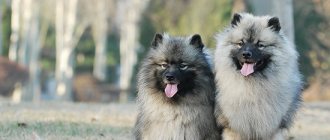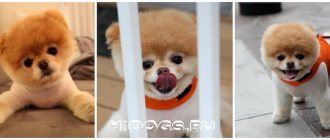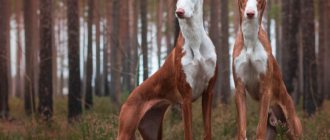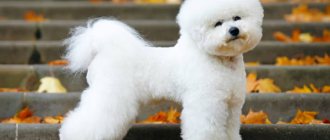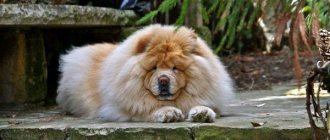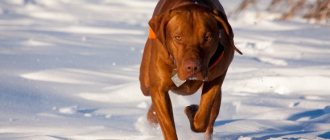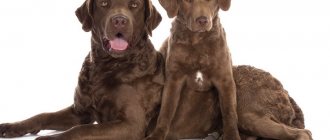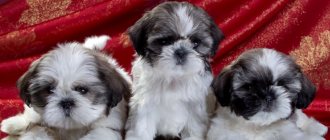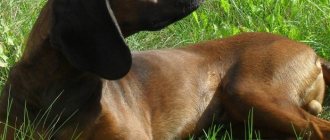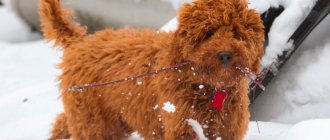| Origin: | Germany |
| Usage: | guard or companion dog |
| Color: | zonal gray |
| Dimensions: | 43-55 cm at the withers |
| Lifespan: | up to 16 years old |
The Wolfspitz Keeshond dog is the largest variety of the German Spitz breed. The compact build, thick coat with a mane and wolf-like coloration make this species attractive to lovers of exotic dogs. At the same time, easy training, intelligence combined with a friendly disposition make it possible to have Wolfspitz dogs as companions.
Breed standard
The appearance standard of the Wolfspitz Keeshond is included in the description of the German Spitz breed, which has been in effect unchanged since 2013. A typical representative is characterized by the following characteristics:
- Compact build in equal proportion of height to body length.
- The head is medium in size and tapers slightly towards the muzzle.
- The length of the Wolfspitz's muzzle to the skull has a ratio of 2 to 3.
- The nose is small with a small black round nose.
- Black lips fit tightly to the jaw with a scissor bite, but a straight bite is allowed.
- The Wolf Spitz has dark oval eyes with a slanted set and black eyelids.
- Small triangular ears are set high, with an elastic stand.
- The back is short and straight, ending in high withers and croup.
- The chest has good depth and is strongly developed in front.
- The medium-sized tail is set high, curled in a loop and lies on the back.
- Straight legs have well-developed muscles.
- The front feet are small and round, cat-type.
- The hind legs are larger and less rounded.
- Coat with two types of hair: top – long and straight; The undercoat is dense and short.
- The coat is long in all areas except the head, ears and paws.
The zoned gray wolf color is a gray color with a silver tint and black tips.
The muzzle is dark with expressive eyes and eyebrows. The fur on the neck and shoulders is pale, as is the fur on the legs, below the knees and elbows. The ears and tip of the tail are black.
Characteristic
The German Wolfspitz Keeshond is energetic, temperamental, self-confident and independent. Loyal to his owner, whom he may even be jealous of. He is sociable, loves his family, is friendly with children, but is wary of strangers. An excellent watchman.
In childhood, the Wolfspitz is like a hurricane, but as it grows up, it becomes calmer, without losing its cheerful disposition.
Spitz have a great sense of a person and their mood. This quality is used by psychotherapists who have noticed that in their presence, patients make contact much easier.
Character
Keeshonds, like all Spitz dogs, have a special cheerfulness and a large supply of energy. With external independence and independence, jealousy may appear in the character of the Wolfspitz.
The dog becomes strongly attached to its owner, and is wary and suspicious of strangers, which is due to its protective instincts. At the same time, representatives of the breed are not prone to aggression. Wolf Spitz dogs are generally friendly and love communication, and do not experience fear or embarrassment.
The Wolfspitz Keeshond shows sensitivity and understanding towards its owner. These qualities greatly facilitate the training of the animal. A developed mind allows a dog to correctly understand what is required of it. Equally, the Wolfspitz is able to respond to the owner’s busyness and will not become annoying and capricious in vain.
Origin story
They got their name for their characteristic color. The first Kees appeared 400 years ago in the Netherlands.
These dogs were available not only to aristocrats, but also to ordinary people. Representatives of the breed herded herds and guarded homes. They were very popular among boat owners and port workers. The dogs guarded the barges and exterminated rats. They were even nicknamed "Dutch barge dogs." The revolution in the Netherlands in 1784-1787 played a cruel joke on the breed, since the leader of the resistance had a Keeshond. At the peak of the revolutionary movement, this contributed to the popularization of the breed. But after the suppression of the revolution, the Keeshonds were practically exterminated. Miraculously, several Kees were saved. In the holds of barges, the Dutch Keeshond dog breed found its way to neighboring Germany. Due to their characteristic color, they were dubbed wolf Spitz or Wolfspitz. At the end of the nineteenth century in Germany, a group of enthusiastic dog breeders began restoring the breed. They did a great job and not only increased the number of Kees, but also developed a standard for all Spitz-types. The First World War stopped the development of the breed. But in 1923, thanks to the efforts of Baroness von Hardenbruck, the Keeshonds were reborn from the ashes. Over the next 10 years, representatives of the breed actively participate in exhibitions and are recognized by the English and American Kennel Clubs.
Wolf-like fluffies came to Russia at the end of the twentieth century as circus performers.
Application
Initially, Keeshonds were used as guard dogs: herding livestock and catching rats and mice. The guarding qualities of Wolfspitz dogs are quite high; they have good hearing and a clear bark. With their voices, dogs report the approach of strangers and possible danger. Now the breed serves to accompany the owner, as a faithful and affectionate pet.
In addition to security activities, the Wolfspitz quickly masters sports sciences. This breed shows good results in dog racing and agility competitions. With proper intensive training, an intelligent wolf copes well with guard duty. Keeshond can also be trained to search for people or to work in the field of zootherapy.
Description
The dogs are distinguished by their large shapes and are recognized as the largest Spitz in the world. A characteristic feature of the Wolfspitz is its thick gray coat and fluffiness. This breed is one of the most ancient, but the dogs’ appearance and behavior have not changed. They are physically developed, tireless, dexterous.
The main purpose of Wolfspitz dogs is to protect household facilities and housing.
With proper upbringing and training, they develop the skills of watchdogs that warn of strangers entering the territory.
Wolfspitz are not intended for the role of bodyguards, they are unable to protect the owner or attack the enemy with the aim of detaining them. The breed is suitable for active people and athletes due to its ability to withstand loads.
Socialization
Wolfspitz gets along well with his owner's family. The dog is friendly, loyal to even small children and tolerates almost everything from them. You can easily buy a puppy as a pet for a child, with whom he will play and have fun.
In case of danger, the Keeshond manifests itself as a true protector and is even capable of biting the offender.
When communicating with other dogs, the Keeshond Wolfspitz can be quarrelsome. But this does not apply to pets living with him in the same house. Proper upbringing from a very early age will allow the Wolf Spitz to coexist peacefully with cats, rodents and birds.
Interesting facts from the life of dogs
For a long period of time, the breed was called barge. This is due to the fact that Wolfspitz dogs were used to guard boats, ships and other vessels. In Holland they are still called the same as when they first appeared.
In the 16th century, the breed was renamed Keeshond and local residents believe that this is a completely different type of Spitz that has nothing in common with the German Wolfspitz.
Spitz dogs have a unique appearance. They know how to smile. To do this, Wolfspitz curl their lips in a special way. You can see the “Dutchman’s smile” when greeting the owner or loved ones. The adult and Keeshond puppy are excellent swimmers, but do not like water.
How to choose a puppy
When you decide to get a Wolfspitz puppy, you need to know everything about the breed and its characteristics in advance. Without much experience, the best place to start is to find an official nursery. When choosing, rely on the following criteria:
- compliance with the breed standard;
- healthy cheerful appearance;
- active cheerful behavior;
- a good appetite;
- absence of fear and nervous trembling.
Often, breeders offer to place a reservation for a puppy from a future litter. In this case, you need to look at photos of Keeshonds who will become parents and get acquainted with their achievements.
They also pay attention to growing puppies from previous matings; they will tell you what the baby will look like in the future.
Video review
It is difficult to convey all the beauty and charm of the breed in photographs and short films about Wolfspitz. But it is impossible not to notice the excessive activity of dogs, combined with obedience. And how beautiful fluffy wool looks, painted in different shades of gray. Wolfspitz is a breed of dog for friendship. They are loyal, obedient and energetic. An inquisitive Keeshond puppy instantly puts you at ease and makes you fall in love with his charming eyes. With proper, consistent training, you can get an intelligent, quick-witted Spitz, capable of understanding a person’s mood on an intuitive level.
Features of maintenance and care
Keeshond Spitz dogs, with their small size, are suitable for keeping in city apartments, as well as in private houses.
Since the breed is a companion dog, it is not possible to keep Wolfspitz outdoors, in an enclosure or a kennel. For them, it is necessary to organize a bed inside the house, close to the owner. Like any decorative dog breed, the Keeshond needs constant grooming, as well as maintaining physical shape.
A balanced diet combined with a long walk will be enough to keep your Wolfspitz fit.
Grooming
Speaking about Wolfspitz, one cannot fail to mention their beautiful thick coat, which requires constant high-quality care. The dog needs to be brushed at least 2 times a week.
During seasonal molting, the procedure is carried out daily. In this case, a special mitten will not be enough; brushes for long-haired dogs or a furminator will be suitable.
Carefully inspect the armpits, ears, mane, tail and panties, where there is a high risk of tangles forming. The beautiful wolf-colored coat cannot be cut, as this will significantly damage the dog’s appearance and reduce protection from insects and overheating.
Keeshonds do not need frequent bathing. Dogs should only be washed if they are heavily soiled.
The specific dog smell is weak in this breed, so water treatments can be limited to once every 3 months. If the dog does not have time to sharpen its claws on its own, they are trimmed as they grow.
Eyes and ears require additional care, which should be cleaned as they become dirty.
Walk
Keeshond puppies are overactive and require a lot of energy. They need to be walked for a long time and often, loaded with sports exercises and active games.
With age, the need for exercise will decrease slightly; walks can be reduced to 2 times a day. Keeshond Wolfspitz dogs are well oriented in the area and are not prone to escape. You can let your dog roam freely at the walking area; he is unlikely to get lost. But on the way to the place it is better to keep the Wolfspitz on a harness. A Keeshond that is carried away by something can run out onto the road and get hit by a car.
Feeding
Caring for Keeshonds requires a balanced diet, which is easier to organize using premium ready-made dry food designed specifically for large Spitz dogs.
Adult dogs are fed 2 times a day, strictly following the recommended amount of food, since the Wolfspitz is prone to overeating.
The diet can also be made up of natural products. In this case, you need to strictly observe the proportions of proteins, fats, carbohydrates, vitamins and minerals.
When a Keeshond puppy appears in the house, it is important to properly organize its nutrition. The break between meals should be approximately equal. After feeding, you need to immediately remove the dog's bowl. But a Wolfspitz should always have access to water. It is forbidden to feed the animal from the table, give treats for no reason, or encourage bad behavior.
Travel companion for energetic people
Wolfspitz is ideal for people leading an active lifestyle. Anyone can envy a dog's endurance. She can easily keep you company on a bike ride or morning jog. You can play alpine skiing and frisbee with your pet - games with a flying saucer. Many owners take part in agility with their pets - controlled obstacle course running.
Although they love to play for hours with children, it is not recommended for younger family members. Just like overly busy people. The dog needs a lot of attention, daily long walks, and various physical activities.
Forced loneliness and confined space negatively affect the animal’s psyche, driving it crazy and making it uncontrollable. In addition, in the absence of the owner, the pet will begin to entertain itself on its own, destroy the apartment and damage property.
Health
Purebred Keeshonds are distinguished by good health and a long life span. This is due to the natural origin of the breed and the long history of its formation.
You can understand what hereditary diseases your pet may develop in the future by looking at the health of the Wolfspitz’s parents. A conscientious breeder will always provide such information about the ancestors of a Keeshond puppy. In old age, the Wolf Spitz is at greater risk of having a malfunction of the endocrine system. Poor diet and improper exercise can lead to the development of heart disease.
Proper prevention and regular check-ups with a veterinarian will help keep your pet healthy.
Diseases
During the development of the breed, the German Spitz acquired an increased risk of developing certain diseases:
- dysplasia and joint dislocations;
- diabetes;
- obesity;
- retinal atrophy;
- cataract;
- epilepsy;
- allergic dermatitis;
- hypothyroidism
In addition, the Keeshond Spitz is prone to Von Willebrand's, Cushing's and Addison's diseases.
Vaccinations
Despite its good immunity, the Keeshond dog breed needs regular vaccinations. The first vaccinations are usually given by the breeder before the puppy goes to its new home.
At the age of 3 weeks, the dog receives anti-helminth medications, which are given again after 1.5-2 weeks. If the baby is healthy, after 10 days you can vaccinate your Wolfspitz against dangerous viruses and infections.
All Keeshond puppies must be vaccinated against:
- plague;
- rabies;
- hepatitis A;
- parainfluenza;
- parvovirus;
- leptospirosis.
Repeated vaccinations and dewormings are carried out annually according to the schedule established by the veterinarian.
Feeding pets
The issue of nutrition for Keeshonds is very important, since they are prone to obesity. Therefore, owners need to carefully monitor their pet’s diet. You can feed the animal with high-quality dry food intended for this type of dog. Feeding should be done twice a day. It is important to follow the instructions on the packaging to ensure you select the correct amount of food.
The issue of nutrition must be approached wisely. Experienced dog breeders recommend following simple rules:
- There should be a strict time interval between meals.
- After a meal, you should not leave the bowl; it is better to hide it away.
- But a container of water should always be ready so that the dog can quench his thirst.
- If you feed your dog prepared food, then you should not offer him food from your table.
- If the animal refuses to eat, then the reason must be identified. Because this can often be a sign of a disease.
- The dog should be accustomed to commands regarding food, so that during walks the food found does not become its food. At your command, the animal must throw the find.
- It is necessary to feed the dog in his absence.
Mating
The first mating of Keeshond dogs is carried out during the female's third heat. For this purpose, it is advisable for a male to reach the age of 2 years.
The following Wolfspitz dogs are allowed for mating:
- with a reliable pedigree;
- corresponding to the photo standard of the breed;
- preferably having awards and titles;
- with a stable psyche;
- not closely related.
Breeding of different types of German Spitz that have differences in size and different colors should not be allowed. Mating is always carried out in the territory of the male and repeated after 24 hours.
Wolfspitz price
One of the main disadvantages of the Wolfspitz is that its price is quite high. On average, the price for a Wolfspitz puppy is about 20,000 - 30,000 rubles.
How much do puppies cost?
The minimum price for a purebred Wolfspitz puppy cannot be lower than 15 thousand rubles. For this amount you can purchase a pet-class baby to keep as a companion, not allowing reproduction. A puppy with a reduced price and without the necessary documents may turn out to be a simple mixed breed.
A high-class Keeshond Wolfspitz with exceptional pedigree, parents with championship titles and full compliance with the breed standard will cost at least 40 thousand rubles.
Reviews
On forums and websites dedicated to dogs, including Wolfspitz, you can find different reviews:
“A lively, energetic, but obedient breed with which you cannot be sad or bored. Spitz gathers his family around him and manages to pay attention to everyone individually. A real mischief maker and a favorite.”
“Wolfspitz dogs have been living with us for many years and never cease to amaze us with their character. For the pranks he has committed, the big fluffy dog falls on his back, like a puppy, and moves his paws, covers his muzzle, and in his eyes there is remorse and a promise to obey.”
“Not a single event is complete without our Wolfspitz. The dog has time to play ball with the children, cook food with me, and go to the garden to collect the harvest. Always nearby, protects and inspects the territory in advance.”
Key points in training
Volspitz dogs are very smart, they need to develop their intelligence in order to fully contact their owner, listen to him and respond to all commands. Therefore, training begins from the first day of arrival in the house.
The dog is raised with strict rules: do not beg, do not whine, do not bite, do not spoil things, do not mark furniture, do not jump on beds, sleep in a designated place. Meals are strictly timed, walking is only in the morning and evening (for adult pets). The owner needs to prove his authority. Otherwise, the dog will sit on the neck and manipulate.
Depending on the purpose of getting a dog, the pet develops special skills. Most often, Keeskhonds are show or circus dogs. Before honing tricks, you need to learn the nickname and basic signal commands: “sit”, “lie down”, “voice”, “quiet”, “place”, “near”, “no”. When the pet remembers the verbal forms, they switch to sound forms (whistle, claps). The dog remembers the name during everyday communication.
If you have problems with training, it is better to immediately contact a canine specialist who will sort out mistakes in training.
Read about how to properly train a dog in the article: “Training a puppy: effective methods from dog handlers, learning commands at home.”
Diseases
Keeshonds are distinguished by excellent health. But they are characterized by some hereditary diseases:
- Hip dysplasia. In the early stages, the disease does not make itself felt, so owners very often are not aware of its presence. Since the disease is hereditary, breeders must take x-rays to rule out the disease. In the later stages of the disease, the dog experiences pain in the joints, limps and cannot even move.
- Subluxation of the kneecap.
- Hypothyroidism. Characterized by insufficient production of thyroid hormones.
- Epilepsy.
- Von Willebranade disease, which causes a bleeding disorder.
- Obesity.
For timely detection of diseases, it is necessary to regularly visit the veterinarian.
Video
The Keeshond is an intelligent breed of dog with an obedient character. The animal quickly gets used to the family and becomes not just a favorite of the household, but their friend and companion. The dog's non-aggressive, playful disposition allows him to get along in families with small children. The cleanliness and unpretentiousness of the breed greatly simplifies the care and maintenance of the pet. We are interested in the opinion of the owners, what approach did you find in raising your pet, did he have allergies, how does molting proceed? What disadvantages do Spitz dogs have? Do they have guard qualities or is it more of a decorative breed? Share your stories with us.
Keeshond appearance
General impression
A sharp mind is not the main advantage of representatives of this breed. The pet has a unique exterior that incorporates the best features of Spitz dogs. In the photo, the Keeshond looks like a miniature and very cute toy.
Head
The skull is medium in size, with a wide occipital region. A smooth stop turns into a neat muzzle. The lip line is slightly tense, which makes the dog appear to be smiling.
Nose, eyes and ears
The eyes are oval and small. The eyelids are dark in color, often black. The ears are small triangular in shape. The tip of the shell is pointed and more rigid. The ears are positioned vertically, which gives the animal a mischievous appearance. The nose is round and black.
Teeth and bite
The teeth are sharp and snow-white. The bite can be either scissor or pincer. The latter option is less preferable for champion producers.
Neck
Purebred kitschhunds have no dewlap, but the scruff has a convex shape.
Torso
Average build. The body is folded harmoniously. The “Dutchman” seems plump only because the coat is too voluminous.
The back is oblong, square in shape. There is a clearly visible bend in the cervical region. The voluminous withers are difficult to see due to the wool collar. The muscles in the front of the body are well developed. The stomach is very tucked.
Forelegs
Wide straight limbs have long shoulder blades. The pasterns are strong. The paws have the most rounded shape.
Hind limbs
Muscular legs with strong thighs. The knees are very powerful. Paws are oval-shaped with black claws.
Tail
The tail is located on the lower back. It is almost always rounded. One of the requirements of the breed standard is a black tip of the tail.
Movements
Wolfspitz has a graceful gait. Thanks to his harmonious physique, his movements are light and fast.
Wool
The main feature of dogs is their gorgeous shiny coat. The Keeshond also has a very soft undercoat. This “set” perfectly warms the dog at low temperatures. Colds are absolutely not dangerous for this breed. Long hair grows over the entire surface of the body.
Color
According to the standard, there are 2 main colors of furry representatives - gray and brown. The first one can be light with a white tint, darker with tiger spots. The presence of black color on the body is necessary. If a puppy is born with a red tint or pure white, it is discarded.
But the fur on a dog’s undercoat can be any color, even beige. A mandatory requirement is to have a black mask on the front of the head. The paws are always light in color, beige or light gray.
Size
The height of the male is 46-48 cm. Exaggeration of these dimensions is unacceptable. The height at the withers of the female is 42-43 cm. The weight of the Keeshond is from 14 to 16 kg.
Larger representatives are German Wolfspitz. Some breeders distinguish them separately, others consider the dogs to be a variety of one breed. In this article, the Keeshond is considered as a separate, independent breed, which has not yet been recognized by the FCI.
Disqualifying faults
The national standards for these representatives of the breed are quite strict. Pets with even the slightest deviations are not allowed to participate in championships. For breeding, only females and males without disqualifying defects are also used.
The most obvious violations may be:
- ears in a semi-erect position;
- eyelids are inverted or rolled in shape;
- wool with white spots;
- not completely overgrown fontanel;
- malocclusion;
- deviations in behavior (too aggressive or shy).
A serious defect is the irregular shape of the skull. Thus, a flat or too rounded head casts doubt on the purebred nature of the breed. A pink nose or light eye color also indicates that the breeder is not working properly.
